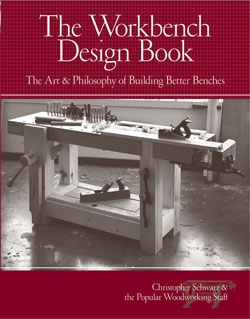New at Lost Art Press: The Workbench Design Book
The Art & Philosophy of Building Better Benches
 This book is the 2010 follow-up to “Workbenches: From Design & Theory to Construction & Use.” It offers nine additional workbench plans, plus it delves deeper into the rules of bench building, new developments in workholding, knockdown workbench hardware and a section that details how you can improve any bench design.
This book is the 2010 follow-up to “Workbenches: From Design & Theory to Construction & Use.” It offers nine additional workbench plans, plus it delves deeper into the rules of bench building, new developments in workholding, knockdown workbench hardware and a section that details how you can improve any bench design.
Why did I write another workbench book? Do you need both? Read on and I’ll explain.
When I finished my first book on workbenches in 2007, I thought I was through with the topic. I had built two excellent ancient forms of benches – an English one and a French one – and had figured out the vises, holdfasts and clamps that helped me build furniture.
The book came out in November 2007, and since then I have been swamped with e-mails and letters from woodworkers who have been inspired, challenged or even angered by the ideas in that book. They have sent me photos of their benches. Sent me treatises trying to poke holes in my approach. And most of all, they made me think deeper on the topic of workbench design.
So I proposed a follow-up book to my employer, F+W Media, that I would write – but without additional compensation. In other words, I received no additional money for this book. I’m telling you this because it would be easy to assume this book is just me cashing in on the success of the first book. My family wishes that were so.
This book is printed in the United States, is twice the length of the first book (at 256 pages) and uses a font that is easier to read than the one in the first “Workbenches” book (thank goodness).
The content is also quite a bit different than the first book. Here’s a list:
• There are nine different workbench plans that cover a wider range of construction techniques and design philosophies. I built most of the benches, though some were built by colleagues I respect. All the benches have faced their trials in our shop. And at the end of each plan, the builder recounts what he or she would change about their design after a few years of use.
• There is a section on the rules (let’s say “guidelines”) for building benches. I probe more deeply into the topics of wood selection, gross bench size, joinery and finish.
• In the last three years, a lot of new vises have been introduced. Some of these vises are huge improvements over the traditional forms.
• There is an entire chapter devoted to knockdown hardware for workbenches, which I didn’t have room for in the first book.
• There are plans for additional workbench appliances, including a bench slave, a Moxon double-screw vise, a sticking board and lightweight sawbenches.
• And there is — for lack of a better word — a bench makeover chapter at the end. In it I pick apart some common bench designs and show you what I would change to make it a better bench.
That last chapter is important because it is the point of the entire book. With all the different bench forms presented in this book, the deeper thoughts on design, and the new workholding available, you should be able to design or modify any workbench design so that it performs at a higher level than the stock designs you see in many stores.
Do you need both books?
That’s a fair question. I think that most woodworkers will be happy with the designs in the first book. It’s like buying a stock Honda Civic and modifying the heck out of the thing. Change the VTEC timing, mess with the cold-air intake, redo the exhaust and suspension. In the end you will have a car that is a top performer, but it still has the Honda Civic nameplate on it.
This book is for people who want to build a car from scratch. Weld together a chassis and pick out all the parts, from the coil to the water pump. It’s more effort to understand the car, which is – ultimately – a group of systems. But the result is that whatever you build in the end – fantastic or craptacular – is entirely your brainchild.
Your bench might end up looking like a Roubo or a Nicholson or a Klausz to a casual observer. But because you understand how all its systems work together you will have created a John-style bench or a Janet-inspired design.
If you’re ready for this, then the first step in your education is to revisit the rules of workbench design and see if we can stretch them, distort them or make them write bad checks.
To order your copy for $34, visit our store.